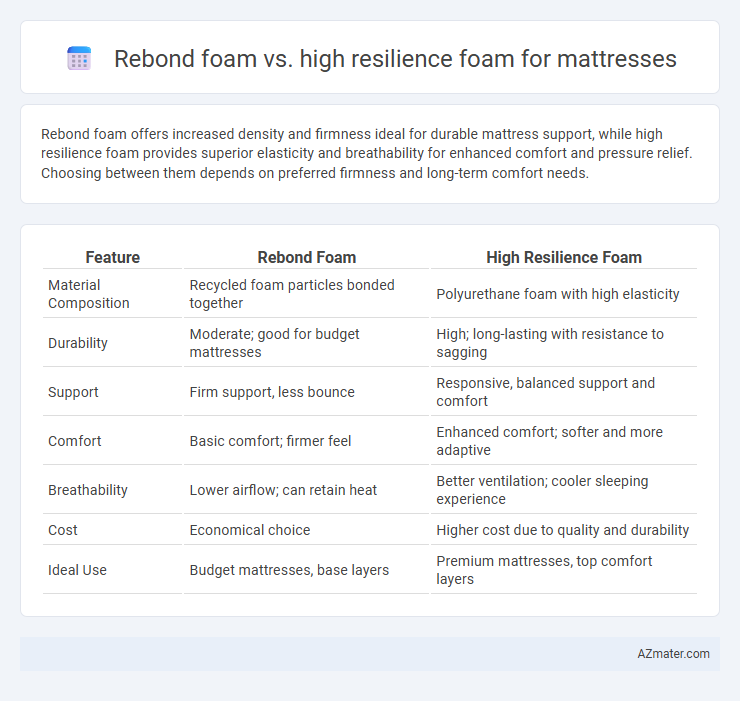Rebond foam offers increased density and firmness ideal for durable mattress support, while high resilience foam provides superior elasticity and breathability for enhanced comfort and pressure relief. Choosing between them depends on preferred firmness and long-term comfort needs.
Table of Comparison
| Feature | Rebond Foam | High Resilience Foam |
|---|---|---|
| Material Composition | Recycled foam particles bonded together | Polyurethane foam with high elasticity |
| Durability | Moderate; good for budget mattresses | High; long-lasting with resistance to sagging |
| Support | Firm support, less bounce | Responsive, balanced support and comfort |
| Comfort | Basic comfort; firmer feel | Enhanced comfort; softer and more adaptive |
| Breathability | Lower airflow; can retain heat | Better ventilation; cooler sleeping experience |
| Cost | Economical choice | Higher cost due to quality and durability |
| Ideal Use | Budget mattresses, base layers | Premium mattresses, top comfort layers |
Introduction to Rebond Foam and High Resilience Foam
Rebond foam is made by compressing and bonding shredded foam pieces, resulting in a dense, firm material ideal for durable mattress support and pressure distribution. High resilience foam offers superior elasticity and responsiveness with a porous structure that enhances breathability and comfort through improved motion isolation. Both foams cater to different mattress needs: rebond foam emphasizes durability and support, while high resilience foam prioritizes comfort and resilience.
Composition and Manufacturing Processes
Rebond foam consists of shredded foam scraps bonded together using adhesives and compressed into dense blocks, optimizing sustainability by recycling materials from polyurethane foam production. High resilience foam is produced through a specialized polyurethane formulation and a controlled reaction process that enhances its elasticity, offering superior durability and support. The manufacturing of rebond foam emphasizes bonding and compression techniques, while high resilience foam relies on precise chemical reactions and curing times to achieve its characteristic open-cell structure.
Key Differences: Structure and Density
Rebond foam, made from shredded polyurethane foam pieces bonded together, has a denser and firmer structure, typically ranging from 50 to 70 kg/m3, providing strong support and durability. High resilience (HR) foam features an open-cell structure with a lower density, usually between 40 to 60 kg/m3, offering enhanced elasticity and better pressure relief. The primary structural difference is rebond foam's composite, rigid form suitable for support layers, whereas HR foam's flexible, responsive design promotes comfort and motion isolation.
Support and Comfort Levels Compared
Rebond foam offers firm support with moderate comfort, making it suitable for individuals needing enhanced body support and pressure relief. High resilience foam provides superior cushioning and responsiveness, delivering a balanced combination of comfort and durable support that adapts well to various sleeping positions. Comparing the two, high resilience foam tends to offer better comfort levels while rebond foam excels in offering consistent, firm support.
Durability and Longevity Analysis
Rebond foam, made from shredded foam pieces bonded together, offers moderate durability but tends to break down faster under long-term pressure compared to high resilience foam, which is engineered with a higher density and elasticity to maintain shape and support over years of use. High resilience foam's superior cell structure provides enhanced resistance to sagging and deformation, making it a preferred choice for mattresses requiring extended longevity. Durability tests reveal that high resilience foam consistently outperforms rebond foam in retaining firmness and structural integrity after prolonged compression cycles.
Breathability and Temperature Regulation
Rebond foam offers moderate breathability but tends to retain more heat due to its dense structure, making it less effective in temperature regulation compared to high resilience foam. High resilience foam features an open-cell design that promotes better airflow, enhancing breathability and maintaining a cooler sleep surface. This superior temperature regulation makes high resilience foam a preferred choice for hot sleepers seeking optimal comfort.
Health and Allergen Considerations
Rebond foam, made from recycled foam scraps, tends to have a denser structure that may trap allergens and dust mites more readily than high resilience foam, impacting respiratory health. High resilience foam offers superior breathability and hypoallergenic properties, reducing the risk of allergen accumulation and providing better moisture control. Choosing high resilience foam mattresses can support a healthier sleep environment, especially for individuals with allergies or asthma.
Cost Comparison and Value for Money
Rebond foam, made from recycled foam scraps bonded together, typically costs less than high resilience (HR) foam, making it a budget-friendly option for mattresses. HR foam offers superior durability, support, and breathability, often leading to a longer-lasting mattress with better comfort, which can provide greater value for money despite its higher price. Choosing between rebond foam and HR foam depends on prioritizing upfront cost savings or long-term investment in mattress quality and lifespan.
Best Use Cases: Who Should Choose Which?
Rebond foam, made from shredded polyurethane foam bonded together, offers durable support ideal for budget-conscious consumers and heavy sleepers seeking firm, dense cushioning for mattresses and orthopedic use. High resilience foam provides superior elasticity, breathability, and responsiveness, making it perfect for hot sleepers, those needing pressure relief, and individuals preferring a bouncy, comfortable mattress experience. Choosing rebond foam suits applications demanding firmness and impact absorption, while high resilience foam excels in delivering long-lasting comfort and enhanced body contouring.
Final Verdict: Which Foam is Best for Mattresses?
High resilience foam offers superior durability, better support, and enhanced pressure relief, making it ideal for long-term mattress use. Rebond foam, often made from recycled foam scraps, provides a firmer feel with less breathability and can be less resilient over time. For optimal mattress performance and comfort, high resilience foam is the best choice due to its balance of resilience, comfort, and longevity.

Infographic: Rebond foam vs High resilience foam for Mattress
 azmater.com
azmater.com